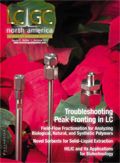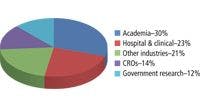Optimizing GC–MS Methods
Many "minor" variables in GC–MS analysis can be optimized to improve selectivity or sensitivity.
There are many "minor" variables in gas chromatography–mass spectrometry (GC–MS) analysis that can be optimized to improve selectivity or sensitivity, and knowledge of these is important in getting the most from your analytical methods. What follows is a brief summary of some of the simpler ways to improve your GC–MS analyses — go to ChromAcademy.com for a more detailed description.
Column bleed should be avoided in GC–MS because it significantly lowers detection limits and adds to the spectral noise when qualitative analysis is required. Ensure you have high-capacity oxygen and hydrocarbon traps fitted to the carrier-gas line, use "MS" designated (low-bleed) columns where possible, and condition columns properly before installation into the detector — this will mean passing carrier gas through the column at room temperature for at least 10 min before thermally cycling the column, which will usually not require more than 30 min at the isothermal temperature limit. To check for column bleed one would investigate a spectrum of the baseline of a total ion chromatogram (TIC) and note ions at 207, 267, and 281 — these ions indicate the presence of siloxane column bleed products.
Ensure that Vespel (Dupont)/graphite ferrules are used to prevent oxygen permeation, and avoid wider bore or short columns that require very low carrier gas head pressures because the carrier flow may not be reproducible with vacuum outlet conditions. Always work within the specified tolerances of the mass spectrometer pumping equipment to maintain a good level of vacuum within the instrument and improve sensitivity (this will typically be a 2–4 mL/min flow of carrier gas depending upon instrument design). The quality of the vacuum (and hence instrument sensitivity) will be directly influenced by the quality of the roughing pump oil, which should be replaced and "ballasted" to expel impurities on a weekly basis to optimize instrument sensitivity.
Most systems use perfluorotributylamine (PFTBA) as a tuning compound to optimize the ion source settings and mass analyzer calibration. This compound is suitable because it is volatile at room temperature under vacuum, contains no mass deficit due to the lack of hydrogen atoms, and fragments reliably to give ions over a wide mass range. Most manufacturers will use ions at m/z 69, 219, and 502 to perform the sensitivity optimization and mass axis calibration of the instrument; although these ions represent a wide range of masses and relative abundance, they may not be suitable for "target tuning" the equipment for high sensitivity at masses relevant to your particular analysis. The relative "normative" benefits of autotuning are outside the scope of this piece; however, to obtain the maximum performance from GC–MS equipment, one needs to appreciate the "manual" tuning benefits.
Many electrostatic components of a modern ion source will be "tunable" by monitoring ion abundance against applied voltage for a range of ions, which are typically user selectable. Selecting the voltage corresponding to optimum ion abundance for an ion whose mass is close to your target ions for the repeller or pusher electrode, for example, can often lead to an increase in instrument sensitivity in selected ion monitoring (SIM) mode. Other ion source components may be optimized using such voltage "ramping" techniques, and one may need to iterate ion source voltages for beam formation, focusing, and acceleration to find the optimum combination of settings.
The energy of the ionizing electrons is of great importance and when using spectral libraries for qualitative work, the electron energy should be set at 70 eV. For all other purposes, the use of 70 eV is purely arbitrary and it may be that altering the electron energy will aid optimization of a method. Reducing electron energy can lead to the promotion of a more prominent molecular ion, although one should note that the absolute abundance of all ions will decrease exponentially. Increasing the electron energy may improve the abundance of target ions in SIM analysis and hence improve the sensitivity of a method. These parameters should be explored as part of the method optimization where better qualitative or quantitative performance is required. Note that altering electron energy may also affect relative abundances of target and qualifier ions.
The mass analyzing device will almost certainly be capable of tuning to a higher specification than achieved by the autotune routine. For example, most quadrupole mass analyzing devices can be tuned for resolution and sensitivity by altering the magnitude of the applied voltages (DC and AC). An increase in the applied DC voltage will increase spectral resolution, but it will reduce sensitivity and affect all masses to the same extent. An increase in the gain (slope) of applied DC versus applied AC voltages will also reduce sensitivity and improve resolution, but it will affect higher masses to a greater extent. Of course, an increase in sensitivity and a reduction in resolution can be achieved by lowering the applied DC and the gain. These techniques are important approaches to optimizing a GC–MS analysis and more information should be sought from your manufacturer.
For scan data acquisition, keep the mass range as narrow as possible and the number of sampling iterations at each mass as high as possible to obtain good quality spectra; consider only spectra that have been properly background subtracted and are an average of all spectra across the peak apex from half height. For SIM analysis, optimize the ion dwell or recording time and keep the numbers of ions per group at a minimum to ensure optimum sensitivity.
Ensure that the transfer device, ion source, and mass analyzer are at the correct temperature. The optimum temperatures will vary between manufacturer and between electron ionization and chemical ionization modes.

University of Rouen-Normandy Scientists Explore Eco-Friendly Sampling Approach for GC-HRMS
April 17th 2025Root exudates—substances secreted by living plant roots—are challenging to sample, as they are typically extracted using artificial devices and can vary widely in both quantity and composition across plant species.
Miniaturized GC–MS Method for BVOC Analysis of Spanish Trees
April 16th 2025University of Valladolid scientists used a miniaturized method for analyzing biogenic volatile organic compounds (BVOCs) emitted by tree species, using headspace solid-phase microextraction coupled with gas chromatography and quadrupole time-of-flight mass spectrometry (HS-SPME-GC–QTOF-MS) has been developed.
Fundamentals of Benchtop GC–MS Data Analysis and Terminology
April 5th 2025In this installment, we will review the fundamental terminology and data analysis principles in benchtop GC–MS. We will compare the three modes of analysis—full scan, extracted ion chromatograms, and selected ion monitoring—and see how each is used for quantitative and quantitative analysis.
Quantifying Microplastics in Meconium Samples Using Pyrolysis–GC-MS
March 26th 2025Using pyrolysis-gas chromatography and mass spectrometry, scientists from Fudan University and the Putuo District Center for Disease Control and Prevention detected and quantified microplastics in newborn stool samples.
The Role of SPME Combined with GC–MS for PFAS Analysis
Published: March 25th 2025 | Updated: March 25th 2025Emanuela Gionfriddo and Madison Williams from University at Buffalo, the State University of New York, NY, USA discuss the important role that solid-phase microextraction (SPME) techniques with gas chromatography mass spectrometry (GC–MS) can play in the analysis of per- and polyfluoroalkyl substances (PFAS).





